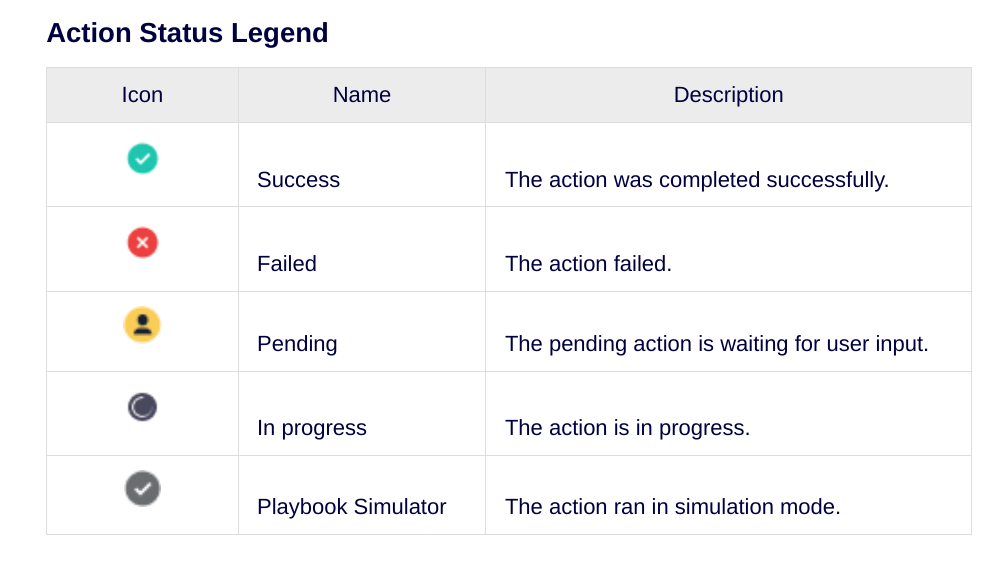浏览“策略方案”页面
支持的平台:
Google SecOps
SOAR
playbook 基于触发器、操作和流程构建,可协同工作,自动执行突发事件响应和其他安全运维任务。当触发器启动 playbook 时,它会执行一系列已定义的操作,以实现特定的解决方案。
playbook 的执行遵循有条不紊的流程:
- 触发器(黄色框):这是启动 playbook 的强制性第一个组件。它定义了导致 playbook 运行的条件或事件。
- 操作(蓝色框):触发器触发后,playbook 会转到一组必须执行的已定义操作。这是剧本执行的具体任务或操作,例如丰富数据、通知用户或隔离遭入侵的主机。
- 流程(紫色框):最后一个组件涉及确定 playbook 的流程,通常使用“if-then-else”条件。此方法使策略方案能够根据之前操作的结果做出决策,并分支到不同的路径以实现最终解决方案。
打开“Playbook”页面
如需打开 Playbook 页面,请依次前往响应 > Playbook。
您可以执行以下操作:
-
Plus
 :添加新的战术或模块。为新 playbook 或代码块选择文件夹和环境。您可以选择一个或多个环境、环境组,也可以同时选择环境和环境组。如果剧本与特定环境组相关联,那么当环境组的范围发生变化时,剧本的范围会自动更新。
:添加新的战术或模块。为新 playbook 或代码块选择文件夹和环境。您可以选择一个或多个环境、环境组,也可以同时选择环境和环境组。如果剧本与特定环境组相关联,那么当环境组的范围发生变化时,剧本的范围会自动更新。
-
修改
 :选择单个或多个 playbook 和功能块,以便与操作菜单搭配使用。如需重命名文件夹,请点击修改,将指针悬停在文件夹名称上,然后输入新名称。修改 playbook 后,您可以根据需要删除 playbook。
:选择单个或多个 playbook 和功能块,以便与操作菜单搭配使用。如需重命名文件夹,请点击修改,将指针悬停在文件夹名称上,然后输入新名称。修改 playbook 后,您可以根据需要删除 playbook。
-
过滤
 :点击
filter_alt
过滤,然后根据以下条件过滤显示内容:
:点击
filter_alt
过滤,然后根据以下条件过滤显示内容: - Playbook 模拟器已开启切换开关
- 显示有效的 playbook 切换开关
- 优先级:设置提醒的 playbook 附件顺序。 系统会根据优先级自动附加一个 playbook。
- 环境:用于多选环境和环境组的选项。
- 菜单
 :点击
修改
修改,然后选择所需的剧本或块,再使用菜单执行批量操作:
:点击
修改
修改,然后选择所需的剧本或块,再使用菜单执行批量操作: - 新建文件夹:添加新的 playbook 文件夹;playbook 会自动继承对其关联的环境组所做的任何更改。您可以将与环境组关联的剧本应用于源自这些组中任何环境的支持请求。
- 复制:使用以下选项创建重复的 playbook:
- 保留或更改优先级
- 保留在同一文件夹中或移至其他文件夹
- 单个、多个或所有环境,其中所有表示所有已定义的环境(包括当前环境和未来环境)。
- 导出和导入:在预发布服务器和生产服务器之间转移策略方案和策略方案块。导出或导入剧本时,会包含其自定义视图。系统仅接受 ZIP 文件进行导入。
- 移至:将 playbook 和块移至其他文件夹,或创建新文件夹。
- 删除:删除 playbook 和区块。点击修改后,您可以删除剧本。
Playbook Designer 的顶部部分
Playbook 设计器的顶部部分提供了 playbook 的全面概览和基本控件。 您会看到以下功能:
- 水平切换开关,用于启用或停用 playbook,可快速启用或停用。
- 简明扼要的摘要,详细说明了剧本的名称、创建者、创建时间戳和关联的环境,以及简短的说明。
- 激活模拟器以进行测试,并添加自定义视图以提高曝光度。
借助 Playbook 设计器的功能,您可以执行以下操作:
| 图标 | 说明 |
|---|---|
|
打开步骤选择 |
打开一个侧边抽屉,其中包含可用的触发器、操作、流程和块。 |
|
适合屏幕大小 |
自动调整剧本,使其完全显示在屏幕上。 |
|
重新排列 |
将 playbook 恢复为默认排列方式。 |
|
缩放 |
放大 playbook 中的一个或多个步骤。 |
|
下载 |
以 PNG 文件格式下载剧本。 |
|
撤消 |
还原您所做的任何更改。 |
|
重做 |
修改您之前撤消的所有更改。 |
|
Playbook 监控 |
显示各个剧本的统计信息。 |
|
Playbook 导航器 |
显示所有 playbook 操作和流程。 |
如需详细了解 Playbook 页面以及如何通过该页面进行协作,请参阅以下内容:
Playbook 图标图例
当附加了 playbook 时,支持请求 > playbook 标签页上会显示以下图标。


需要更多帮助?从社区成员和 Google SecOps 专业人士那里获得解答。

